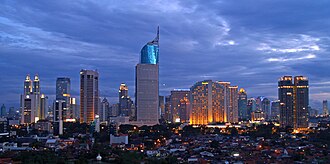Economy
Main article: Economy of Indonesia
Indonesia has a mixed economy in which both the private sector and government play significant roles.[113] The country is the largest economy in Southeast Asia and a member of the G-20 major economies.[114] Indonesia's estimated gross domestic product (nominal), as of 2012 was US$928.274 billion with estimated nominal per capita GDP was US$3,797, and per capita GDP PPP was US$4,943 (international dollars).[115] The gross domestic product (GDP) is about $1 trillion[4] and the debt ratio to the GDP is 26%.[116] According toWorld Bank affiliated report based on 2011 data, the Indonesian economy was the world's 10th largest by nominal GDP (PPP based), with the country contributing 2.3 percent of global economic output.[117][118] The industry sector is the economy's largest and accounts for 46.4% of GDP (2012), this is followed by services (38.6%) and agriculture (14.4%). However, since 2012, the service sector has employed more people than other sectors, accounting for 48.9% of the total labour force, this has been followed by agriculture (38.6%) and industry (22.2%).[119] Agriculture, however, had been the country's largest employer for centuries.[120][121]
According to World Trade Organization data, Indonesia was the 27th biggest exporting country in the world in 2010, moving up three places from a year before.[122] Indonesia's main export markets (2009) are Japan (17.28%), Singapore (11.29%), the United States(10.81%), and China (7.62%). The major suppliers of imports to Indonesia are Singapore (24.96%), China (12.52%), and Japan (8.92%). In 2005, Indonesia ran a trade surplus with export revenues of US$83.64 billion and import expenditure of US$62.02 billion. The country has extensive natural resources, including crude oil, natural gas, tin, copper, and gold. Indonesia's major imports include machinery and equipment, chemicals, fuels, and foodstuffs, and the country's major export commodities include oil and gas, electrical appliances, plywood, rubber, and textiles.[89]
The tourism sector contributes to around US$9 billion of foreign exchange in 2012, and ranked as the 4th largest among goods and services export sectors.[123] Singapore, Malaysia, Australia, China and Japan are the top five source of visitors to Indonesia.
In the 1960s the economy deteriorated drastically as a result of political instability, a young and inexperienced government, and economic nationalism, which resulted in severe poverty and hunger. By the time of Sukarno's downfall in the mid-1960s, the economy was in chaos with 1,000% annual inflation, shrinking export revenues, crumbling infrastructure, factories operating at minimal capacity, and negligibleinvestment. Following President Sukarno's downfall in the mid-1960s, the New Order administration brought a degree of discipline to economic policy that quickly brought inflation down, stabilised the currency, rescheduled foreign debt, and attracted foreign aid and investment. (See Berkeley Mafia). Indonesia was until recently Southeast Asia's only member of OPEC, and the 1970s oil price raises provided an export revenue windfall that contributed to sustained high economic growth rates, averaging over 7% from 1968 to 1981.[124]Following further reforms in the late 1980s,[125] foreign investment flowed into Indonesia, particularly into the rapidly developing export-oriented manufacturing sector, and from 1989 to 1997, the Indonesian economy grew by an average of over 7%.[126][127]
Indonesia was the country hardest hit by the Asian financial crisis of 1997–98. During the crisis there were sudden and large capital outflows leading the rupiah to go into free fall. Against the US dollar the rupiah dropped from about Rp 2,600 in late 1997 to a low point of around Rp 17,000 some months later and the economy shrank by a remarkable 13.7%. These developments led to widespread economic distress across the economy and contributed to the political crisis of 1998 which saw Suharto resign as president.[128]The rupiah later stabilised in the Rp. 8,000 range[129] and economic growth returned to 4% per year by 2000.[130] However, the currency still fluctuates, dropping below Rp 11,000 per dollar in September 2013. In addition, corruption has been a persistent problem. Transparency International, for example, has since ranked Indonesia below 100 in itsCorruption Perceptions Index.[131][132] Since 2007, however, with the improvement in banking sector and domestic consumption, national economic growth has accelerated to over 6% annually[133][134][135] and this helped the country weather the 2008–2009 global recession.[136] The Indonesian economy performed strongly during the Global Financial Crisis and in 2012 its GDP grew by over 6%.[137] The country regained its investment grade rating in late 2011 after losing it in the 1997.[138] However, as of 2012, an estimated 11.7% of the population lived below the poverty line and the official open unemployment rate was 6.1%.[89]
source wikipedia



No comments:
Post a Comment